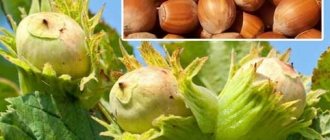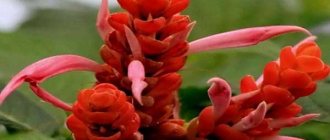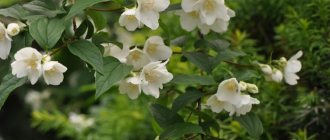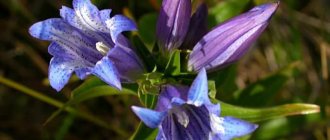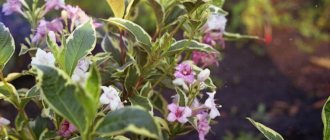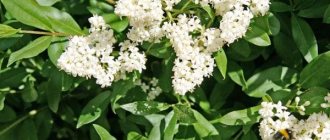Mango is a common exotic fruit. It grows mainly in India, as well as in a number of other tropical countries. Its main value lies in its soft, juicy pulp and pleasant sweet taste with a slight sourness. Special substances contained in its peel can cause allergic reactions in some people.
But, despite this, almost every one of us has tried it at least once and therefore knows that there is a large oblong bone inside the fruit. It can be easily germinated. So how does a mango grow?
How does it grow in nature?
You can admire how mangoes grow in nature in a number of tropical countries. There, this crop, together with other trees, forms dense forests. When a mango grows in natural conditions, the tree looks like this:
- height 25–30 meters or more;
- crown diameter 7–8 meters;
- leaf blades are lanceolate-shaped, up to 40 cm long;
- young leaves grow burgundy at first, and then acquire their characteristic green color.
When mango grows in nature, its flowering period is in February or March. Its small yellow flowers are collected in fairly large pyramidal inflorescences. Their length can be 40 centimeters or more. The scent of the flowers of this tree is similar to that of lilies. A large number of insects and bats flock to it. After setting, the fruits grow within 3 months.
Mango is long-lived. It can grow over several centuries. There are trees 300 years old that are still actively growing and bearing fruit.
The mango root is a taproot, it goes to a depth of over 6 meters. But even with such an impressive size, it is not able to hold a tree. Therefore, mango additionally develops a wide and highly branched root system. The tree grows unevenly throughout the year. It has several periods of intensive development. But despite this, mangoes bear fruit only once. Under cultural cultivation conditions, agronomists manage to obtain two waves of fruiting.
Mango is a fruit and ornamental plant
Mango, or mangifera, is cultivated as a fruit and ornamental plant. Evergreen trees Mangifera indica (Indian mango) belong to the Sumacaceae (Anacardiaceae) family. They have glossy dark green (or reddish-tinged) foliage and grow to gigantic sizes. But with proper and regular pruning they can be quite compact.
A mango tree during flowering is an unforgettable sight. It is strewn with large pink panicle inflorescences, emitting a unique aroma. Therefore, the plant is grown not only for its fruits, but also for use in landscape design (in the design of parks, squares, garden plots, private greenhouses, winter gardens, etc.). However, its main purpose in exporting countries is still agricultural.
This is how green (Filipino) mango grows
Countries and regions of growth
Mangifera is native to the humid tropics of Assam, India, and the forests of Myanmar. It is considered a national treasure among Hindus and Pakistan. It is grown in tropical Asia, in the west of Malesia, in the Solomon Islands and east of the Malay Archipelago, in California (USA) and tropical Australia, in Cuba and Bali, the Canary Islands and the Philippine Islands.
India is considered the largest supplier of mango fruits in the world - it supplies the market with more than thirteen and a half million tons of these fruits per year. Mangoes are also cultivated in Europe - on the Canary Islands and Spain. Ideal conditions for the plant are a hot climate with not too much rainfall. Despite the fact that mango juice produced in Armenia can be found on supermarket shelves, mangifera does not grow in Armenia.
You can find her:
- in Thailand - the country's climate is perfect for tropical plants, the mango harvest season here is from April to May, and the Thais really like to feast on ripe fruits;
- in Indonesia, as well as in Bali, the mango harvesting season is autumn-winter, from October to January;
- in Vietnam - winter-spring, from January to March;
- in Turkey - mangifera is not particularly common, but is grown and ripens in the middle or towards the end of summer;
- in Egypt - mangoes ripen from the beginning of summer, June, until autumn, until September, they are even exported to other countries;
- In Russia - in the south of the Stavropol and Krasnodar regions (Sochi), but rather as an ornamental plant (blooms in May, and bears fruit by the end of summer).
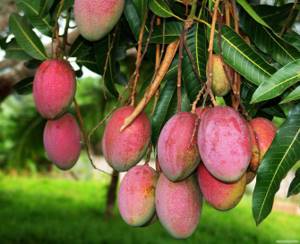
Indian mango fruits on a tree
The genus has more than 300 species, some varieties were cultivated several thousand years ago. In tropical countries you can try Alfonso, Bauno, Queeni, Pajang, Blanco, fragrant, bottled and other mangoes; in Russia, mangoes of Indian varieties, with a reddish barrel, and mangoes of South Asian (Philippine) varieties - green, are more often sold.
Mangifera is very sensitive to cold, which is why in mid-latitudes it can only be grown in heated rooms - winter gardens, greenhouses, greenhouses. Trees need a lot of light, but they do not need rich soil.
Young trees will be negatively affected by even a short-term drop in air temperature below plus five degrees Celsius - their flowers and fruits will die. Mature mangoes can withstand light frosts for short periods of time.
Video: how mango grows
Can it be grown at home?
How to grow mango at home? - you ask. After all, in nature it is a huge tree with a wide spreading crown. So, for growing indoors, dwarf varieties and grafted plants are mainly used. They grow in the form of small compact trees ranging in height from 70 cm to 1.5 meters. When growing grafted plants, the role of the rootstock is played by the seedlings grown from the seed.
If it is not possible to vaccinate or purchase a special dwarf variety, they are limited to constant formative pruning. To do this, 4–5 main branches are left on the tree, and the rest are cut out. Mango grows quite intensively, so its crown is trimmed several times a year.
This is interesting! Delicious mango recipes.
Long-lived tree
Shady mango trees with a wide rounded crown grow up to twenty meters or more in height, develop very quickly (if they have enough warmth and light, and the humidity is not too high) and live for a long time - there are even three-hundred-year-old specimens in the world that even at such a respectable age bear fruit. Access to water and useful minerals in the soil is provided to these plants by long roots (taproot), which grow underground to a depth of five to six, or even nine to ten meters.
Mangoes are evergreen and non-deciduous, very beautiful trees. They are decorative all year round. The leaves of ripe mangoes are oblong, dark green above, and much lighter below, with clearly visible pale veins, dense and glossy. The young foliage of the shoots has a reddish color. The inflorescences look like panicles - pyramidal - with up to two thousand yellow, pinkish or orangeish, and sometimes red flowers each. But only a few of them (two or three per inflorescence) are pollinated and bear fruit. There are varieties that do not require pollination at all.
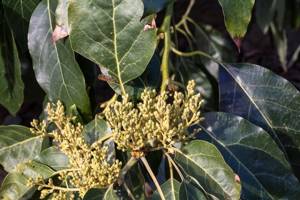
Pyramidal mango inflorescences
In conditions where humidity is high and there is a lot of precipitation, mangifera does not bear fruit. Fruits also do not set when the air temperature (including at night) drops below plus twelve degrees Celsius. Mango trees begin to bloom and bear fruit only five to six years after they are planted. In a greenhouse or at home, you can see mangifera flowers and fruits only if you buy grafted seedlings or plant them yourself. And at the same time, observe the necessary parameters of humidity and air temperature, properly care for and prune.
In the countries where it grows, mangifera forms entire mango forests and is considered the same agricultural crop as in our country, for example, wheat or corn. Under natural conditions (in the wild), the plant can reach thirty meters in height, has a crown diameter of up to eight meters, and its lance-shaped leaves grow up to forty centimeters in length. After pollination of flowers, the fruits ripen within three months.
Recent Entries
5 working ways to use tar in the garden 7 indoor plants that help you get married even in adulthood Indoor plants that can bloom in trouble
Only under cultivated conditions is it possible to obtain two mango harvests; in the wild, mango trees bear fruit once a year.

This is how mangifera blooms
How to grow from a seed in a pot?
Many gardeners are very interested in the question of how to grow mangoes from seeds? So, this is not difficult to do. The main thing is to stock up on seeds from well-ripened fruit. It can be determined by the following characteristics:
- The skin is reddish or yellowish in color.
- Soft pulp.
- Easily detachable bone.
Advice! If you are interested in how a mango seed grows, then when choosing a fruit, give preference to very overripe ones. The bones in them very often begin to grow on their own.
How to germinate?
Growing mangoes at home should begin with germination. To do this, the seed is first thoroughly cleaned. If this step is neglected, mold will appear in the process, which will destroy it.
Attention! Germination begins immediately. Dried seeds will not grow.
The bone, cleared of pulp, is placed in a container with warm boiled water. The water should be changed once a day. Once it starts to grow, it can be planted.
How to germinate a mango seed in another way? There is another germination option. The seed is simply wrapped in a damp towel and placed in a warm place. In this case, you need to ensure that the towel is constantly damp. As soon as the seed begins to grow, it can be planted. So how to plant a mango seed?
How to plant?
After germination, another question arises for the gardener: how to plant a mango seed at home? So, for this you will need:
- pot with a diameter of 10–12 cm;
- universal primer;
- a small amount of expanded clay.
The planting process itself is very simple; first, a drainage hole is made in the bottom of the pot. Then the universal primer is mixed with expanded clay. The resulting soil mixture is poured into the pot.
Attention! The main requirement for the soil mixture is a neutral level of acidity. The seedling will not grow in soil with a different acidity. It will gradually wither away and eventually die.
It is also important to pay attention to how the mango seed should be planted. If it is already growing, it should be planted horizontally. In other cases, landing is carried out sideways. Whatever planting method is chosen, it cannot be completely covered with soil. There should be at least a quarter of it above the soil surface.
After completing the planting work, caring for the planted seed is as follows:
- The pot is watered generously with warm water.
- An improvised greenhouse is built above the planting site from the cut off top of a plastic bottle. In order to ventilate, the plug on it sometimes needs to be unscrewed.
- Before the seed begins to grow, it is kept in a warm, bright place.
- You also need to constantly monitor the level of soil moisture and water if necessary.
On average, germination takes one to two months. If there are no sprouts for a long time, you can try using growth stimulants. For example, Epin stimulates growth processes well. The planting site is watered with its solution.
Several sprouts usually appear from one seed at once. One of them always grows more actively. It should be left and the rest carefully removed. At first the sprout grows very, very slowly, but gradually its development accelerates significantly.
Caring for a young, fragile plant should be very careful:
- At first, it should be watered regularly and abundantly. At the same time, the main thing is to prevent flooding. To allow excess moisture to drain freely, drainage holes must be punched in the bottom of the pot.
- Also, from the first month of life, the sprout can be fed. For this purpose, mineral complexes for decorative foliage plants are used. They should be bred in strict accordance with the attached instructions.
Attention! After watering, the surface of the soil in the pot must be loosened. Oxygen starvation will cause the seedlings to grow very slowly.
After we learned how to plant a mango and how the seedling grows, it wouldn’t hurt to get acquainted with the rules of care.
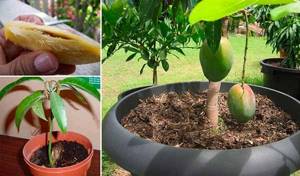
This is what a mango sprout looks like
Care
Caring for mangoes at home is not at all difficult. The main thing is to create the following growing conditions:
- Lighting. The mango plant grows best under intense light. Therefore, it is best to place a pot with it on a window oriented to the south. So that the mango can grow successfully in winter, it is provided with additional lighting from fluorescent lamps. This will prevent unwanted stretching of the shoots.
- Air humidity. Seed mangoes are very adaptable. The tree grows without problems in normal room conditions with dry air. But despite this, it requires regular spraying with soft water at a temperature slightly above room temperature. In winter, the tree grows well even without daily spraying.
- Watering the mango. The plant at home should be watered after the top soil layer has dried. It should not be allowed to dry out completely. For irrigation, only settled water should be used. Mango grows well in constant, moderate humidity.
In addition to observing the above conditions for growing mangoes, a tree at home requires certain care measures:
- Trimming. Seed mango grows very intensively at home, so to maintain its high decorative qualities, it must be pruned. Usually, shaping begins after the mango has grown to a height of 1 meter. First, only the growth point of the main shoot is pinched. After this, side branches begin to grow, which are subsequently also cut off.
- Transfer. Growing mangoes from seed also involves transplanting. During the first 5 years the tree grows intensively, so replanting must be done annually. After that, once every 2-3 years will be enough. Transplantation is carried out in the spring. During this period, the tree begins to grow rapidly and therefore easily tolerates damage to the root system. In this case, the new pot should be slightly larger than the previous one. It is not recommended to replant the plant immediately into a large one.
- Feeding. You can grow mangoes from seeds at home without using fertilizers. But then the tree grows weak and frail. To prevent this during the period of intensive growth, it is fed with a solution of universal fertilizer.
So we learned how to grow a mango with your own hands from an unnecessary seed, but what about its flowering indoors?
Mango fruit
The unusual appearance of mangifera trees always attracts the attention of tourists who visit tropical countries for the first time. Their fruits ripen on long (about sixty centimeters) shoots - former panicles - two or more on each, have an oblong shape (curved, ovoid, flattened), up to twenty-two centimeters long and weighing about seven hundred grams each.
The peel of the fruit is glossy, like wax, and is colored depending on the type of plant and the degree of ripeness of the fruit - in various tones of yellow, orange, red, green. Flower marks are visible at the ends of the fruit. The peel is considered inedible as it contains substances that cause allergic reactions.
Indians and Asians use mango fruits in home medicine - they are considered an effective folk remedy that stops bleeding, strengthens the heart muscle and improves brain activity. Ripe, selected mangoes have a shiny surface, without spots or bruises (the color of the peel depends on the variety), their flesh is not hard, but not too soft, juicy, aromatic, with a fibrous structure. An unripe mango can be wrapped in dark, opaque paper and placed in a warm place. In about a week it will ripen and be ready to eat.
In India, mangifera is eaten at any stage of maturity. The fruits are thoroughly washed, separated from the stone with a knife, peeled and cut into slices. Or cut half the fruit into cubes directly on the peel.

Mango fruits are cut into cubes or slices
Everyone in our family loves mangoes. We eat it fresh or use the pulp of the fruit in combination with other fruits to prepare vitamin cocktails or smoothies, soufflés, mousses, puddings, and homemade baked goods. It turns out very tasty. In salads, mango goes well with seafood and chicken breast. But I couldn’t grow a tree from a seed, although I tried several times. The fact is that tropical fruits are not fully ripe for transportation, and the seeds do not always germinate.
What does mango taste like?
The taste of mango, perhaps, cannot be compared with any other - it is special and unique. Sometimes aromatic, juicy and sweet, sometimes with a pleasant and refreshing sourness. It all depends on the degree of ripeness of the fruit, variety, and region of growth. For example, Thai mangoes have a light pine aroma. The consistency of the pulp of all fruits is thick, tender, somewhat reminiscent of apricot, but with the presence of hard plant fibers. The brighter the mango peel, the sweeter the fruit pulp will be.
Mango juice, if it accidentally gets on clothes, cannot be washed off. The bone is difficult to separate from the pulp. The pulp protects the plant seeds (the seeds inside the fruit) from damage. It contains sugars (more in ripe ones), starch and pectin (more in green ones), vitamins and minerals, organic acids and other benefits.
Unripe mangoes contain a lot of vitamin C and are sour in taste. Ripe mangoes are sweet because they contain a lot of sugars (up to twenty percent) and less acids (only half a percent).
How does this plant bloom?
We’ve already talked about what a mango tree looks like, but how does this crop bloom at home? Mango trees bloom no earlier than 5–6 years from the moment of planting. Up to this point they are simply growing.
But in indoor conditions it is almost impossible to see them bloom. Even if trees grow in a greenhouse or winter garden, it is not always possible to admire the flowers. You can see live how a mango blooms only if the crop grows in natural conditions.
Read how to properly cut a mango here.
Will there be fruit?
When growing mangoes at home from a seed, it is very unlikely to see the fruit itself. Trees that grow in the house can bear fruit only if they are vaccinated. They are purchased from the appropriate nursery. You can also try to vaccinate yourself. To do this you will need the following:
- Rootstock. It uses a mango flower grown from a seed.
- Scion. It uses a bud from a specimen that has produced fruit.
- Sharp knife.
- Insulating tape.
The technique of grafting a mango from a seed growing in a pot is very simple. A T-shaped cut is made on the rootstock. It should be located 1–2 cm from the root collar. Its edges are neatly bent. After that, a previously cut bud is placed at the incision site. All this is securely fixed with electrical tape.
The best time for vaccination is spring. At this time, the mango begins to actively grow, which contributes to the accelerated growth of the graft. In a month it will be clear how successful it was. If the planted bud grows, then the grafting is almost 100% successful.
Further care for the vaccination is as follows:
- After 1–1.5 months you will need to remove the crown of the rootstock. To do this, just above the grafting site, use a sharp knife or pruning shears to cut off the entire main shoot.
- The resulting cut must be covered with a small amount of garden varnish.
After grafting, the tree will grow for about 3 more years until flowering. During this period, the mango will grow its crown. After the ovary has formed, the fruits will continue to grow for another 3–4 months. Mangoes are pollinated very poorly, so there will be very few fruits.
Checking the fruit by touch
How to choose a ripe mango? One of the criteria for determining the ripeness of a mango is to determine its consistency to the touch. This must be done very carefully so as not to crush the fruit, as a result of which after a few days it may simply deteriorate.
If the mango pulp begins to spring back and the consistency of the fruit is quite soft, the fruit is worth buying, as it will definitely be ripe. You should refrain from purchasing the fruit if the flesh is too soft or, conversely, hard and does not spring back.
How to squeeze a mango correctly? Experts note: in order to properly feel the ripeness of a mango to the touch, you need to lightly squeeze it with your palm, and not with your fingers, which have much stronger pressure.
